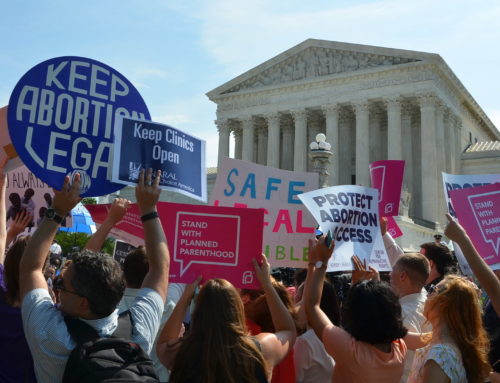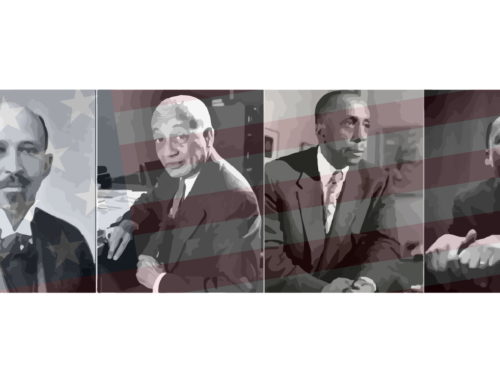By: Anurup Doshi
Racial profiling techniques have been at the heart of debates about crime-fighting for a very long time. The application of such techniques has generally been followed by accounts of abuse and horror stories about harassment. Profiling was the focus of renewed attention in 2016 when Donald Trump called for adopting an Israeli-style practice. Particulars of the Israeli-system aside, profiling techniques are often accused of being outright discriminatory, and of turning generalizations into policy. Even beyond the realm of policy making, the use of a generalization in a social context tends to draw pronounced indignation. Frequently, the statement ‘you must not generalize’ becomes a blanket assertion that is thrown around while talking about different categories of people.
When certain actions based on generalizations proliferate and have wide reaching consequences on society, these actions, and the underlying generalizations, become the target of a great deal of public ire. It can be argued that such outrage is not misplaced. It might also be that a person’s loathing for a generalization is most conspicuous when his or her individual identity is directly challenged by it. That is, however, just a superficial look at the entire picture. A generalization is actually a tool that is used by default, or by design, on a regular basis.
This article aims to separate the formation and usage of a generalization from the effects of acting on it. It explores the manner in which generalizations take root, the pivotal role they play in different contexts, and it attempts to dissect the rationale behind using them in policy making and the nuances associated with the implementation of such policies. Given the pitfalls accompanying such an approach, it also hopes to define some boundaries for subscribing to generalizations.
What is a generalization and where does it come from? As a whole, a generalization is the identification of how detailed facts about a concept relate to a larger set of such facts with relaxed constraints. Generalizations are built on experiences that individuals have had with different entities and also on evidence shown by statistical studies. The more frequently one sees examples of a generalization, the more likely he or she is to believe in it. At a basic level, generalizations are used as mental shortcuts to simplify things, which inevitably saves time in decision making. To refrain from generalizing altogether would be to scrutinize everything to the maximum possible extent.
Keep in mind that taking one particular instance and applying it to the entire sample being studied is inherently wrong. Then again, there is no defined threshold on the number of incidents that need to occur for a generalization to take root. To say that the French are misogynistic because a few French men are misogynistic is inaccurate, because it does not reflect what most French people are like. But, to say that Asian students, in general, are better than their American counterparts at math because the majority of Asian students are better than the majority of American students at math is perfectly acceptable even though there are exceptions to this. [1]
Generalizations are useful in the study of practically everything. They even form the basis for research in cultural, psychological, and gender studies, and the benefits that arise from their application in these areas are great. For example, in his famous book, ‘Thinking Fast and Slow’, Daniel Kahneman successfully demonstrates that professionals are more likely to go wrong about their predictions as time progresses. [2] He cites enhanced overconfidence and an over-reliance on intuition as the causes. Clearly, a sweeping generalization has been made here, as not all professionals are prone to this bias. This conclusion would have probably offended those who believe that their predictions are infallible. But, being wary of such biases has led even seasoned experts to scrutinize their work in a more exhaustive way to minimize scope for error.
Generalizations come into play in different social contexts. Studies conducted by different academic bodies show that men exhibit greater interest in sports and women show greater interest in clothes.[3][4] This gives people a starting point while engaging in a relatively unknown social interaction. In other words, it is easier to strike a conversation with a male stranger about football and with a female stranger about her shoes. Dating advice is given to men and women on similar assumptions. While such advice may not apply to all men and women, the fact remains that it does currently hold for most, and many have benefited from using the same.
More importantly, generalizations play a pivotal role in propagating ideas that can be of use to the population at large. For example, the statement ‘Regular smokers end up suffering from lung cancer’, is a generalization, made from medical studies that show a strong correlation between lung cancer and smoking.[5] It does not imply that all lung cancer patients are regular smokers, nor does it mean that smoking inevitably leads to lung cancer. But, making this generalization makes discourse on the issue easier and ensures greater progress in the fight against lung cancer.
Thus, one can see that at different levels of society recommendable courses of action arise from generalizations. One can also see that the generalizations themselves stem from studies that classify people into different groups on the basis of age, ethnicity, personal preferences, social and economic backgrounds, amongst others. As seen above, these recommendations can be of a beneficial nature.
Laws and policies are established, by and large, to bring about what is thought to be good for society as a whole, and they seem to work well in most cases. The government cannot be expected to create laws for each and every scenario – because it is practically impossible to do so – and then hope that a new situation does not arise where someone is placed at a disadvantage. So, they make group-based decisions from generalizations that are extracted from current empirical data.
Many people nonetheless have a problem with such laws because they seem to generalize about a given community based on characteristics that are not necessarily possessed by all the members of it. The line gets especially blurry when the concept of correlation not implying causation is brought in. There is a rightful individuality that people attribute to themselves, and hence, such measures are bound to seem unfair. However, these policies are necessary at times because the number of people for whom they are made is far too large to have every individual’s particular nuances taken into account. As long as real world considerations are kept in mind, policies based on the right principles have the potential to use resources in the most efficient way possible. For example, it seems unwise to deploy forces uniformly all across a city when it is known that violent crime is greatly predominant in low income neighbourhoods.[6]
Controversial procedures, like the checks conducted at airports and border crossings, are a prime example of policies based on generalizations, and so too of the public dislike of generalizations. Yet, despite the criticism that these procedures draw, law enforcement agencies rely on them while functioning.
When a crime has already been committed, racial and ethnic markers that form a part of a suspect’s description are used to apprehend the said suspect. Such markers help in narrowing down where one is likely to be found, thereby saving resources. When it comes to predicting or attempting to prevent a possible crime, information that can be gained from behavioural indicators and previous investigations is invaluable. This has been at the core of police work for decades. Profiling based on personal characteristics is used to find commonalities between various criminals/crimes, which are then used to identify those most likely to break the law. Such characteristics can be sophisticated classifiers like background factors or simple ones such as gender, age and race.
Depending only on behaviour to identify potential criminals is impossible at busy airports and crossings. A couple of officials cannot be expected to observe the behaviour of millions of passengers passing through checks. Hiring more officials and introducing more scanners would lead to an exponential increase in cost and delays. Moreover, behaviour can be masked. Hence, by using profiling techniques, the skills and insight of the police force can be directed efficiently towards those who are most likely to commit a crime.
There is a difference between hard and soft profiling – the latter uses several factors (which can include race and ethnicity) instead of just one to gauge criminal suspiciousness. Travel patterns and financial transactions have also been used as indicators of suspicious activity. Therefore, engaging in soft profiling seems most likely to yield the best results. It makes sense to identify patterns amongst drug traffickers, terrorists, smugglers and to respond accordingly. The more refined the profile, the better. Since several commonalities do exist between people belonging to a particular community, governments can make policies that are more targeted and can solve specific problems.
A conventionally trained observer would not assume that a middle-aged woman would be someone likely to start a riot at a football stadium. Similarly, one can assume that a bunch of college students travelling from Amsterdam are more likely to be carrying drugs, and hence need to be checked more stringently, than a wealthy businessman travelling across the world for a day. By an extension of earlier arguments, racial and ethnic factors, and geographical origin, amongst others, can be used to prevent crimes from happening in the first place. For example, the current reality is that most of the world’s cocaine is produced in South America, that Africa serves as a major drug trafficking route and that most suspects confirmed to be terrorists are of Middle Eastern origin.[7][8][9] Using such information becomes a practical necessity of sorts because risking lives in the name of political correctness is rather ridiculous. Everyone, including victims of harsh profiling, has a stake in not watching a plane being hijacked. A sensible security policy is one that requires decisions to be made on whatever factual information is presently available. Only so many people can be checked, rechecked, scanned and questioned at an airport.
As explained earlier, a generalization is not a universal truth – there is a far more limited extent to which they can be subscribed to, and a certain cost attached to acting on them. With respect to the above example, the cost could be said to refer to public backlash and an engendering of mistrust in the police force. When a given policy is largely ineffective and the false positives that are encountered are not taken into account, the relevant generalization must be changed. It is the prerogative of law enforcement agencies to revise profiles with respect to new information, or come up with a completely new method, so as to be able to apprehend more perpetrators.
Individuality is important, and it has been given its fair share of wealth in fundamental rights that the constitutions of different countries guarantee. However, these rights aren’t absolute; certain restrictions can be placed on them when there is something greater at stake. Similarly, such restrictions cannot be pushed to logical extremes like engaging in hard profiling based on a single characteristic or unreasonably punishing everyone belonging to a particular category. Just as certain pragmatic concerns force governments to resort to extreme tactics, similar pragmatic concerns must prevent them doing something that is completely unjust.
The above view also holds true while acting on generalizations in different social contexts. By virtue of placing individuality at risk and being based on notions that people are sensitive to, generalizations are naturally going to draw a lot of criticism. One needs to have at least a vague idea of how extreme a generalization is and what the repercussions of acting on it could be. It is also imperative for everyone to realize that the actions they undertake as a result of generalizing should leave scope for revision; external repercussions are far from always being effective in stimulating a corrective change to one’s actions, or to generalizations themselves. However, as one can see in the above examples, the optimal approach is one that employs generalizations, but has them continually revised and shaped into more fitting claims.
In conclusion, it is manifest that the phrase ‘you must not generalize’, is itself a generalization, and hopefully one that will have been revised after reading this article.
Anurup Doshi studies Electrical and Electronics Engineering at BITS Pilani, India. He is a member of the English Press Club and the Debating Society at college. His interests include world politics, ethics, and psychology.
Image: Passengers scan their luggage through an x-ray machine at Aden Adde International Airport in Mogadishu, Somalia, on April 19. After an explosion ripped a hole in the side of a Daalo Airline’s airplane in February of 2016, security at Aden Adde International Airport has been drastically revamped in order to ensure similar incidents do not occur. AMISOM Photo / Tobin Jones
- https://www.omicsgroup.org/journals/a-comparison-study-of-math-education-and-math-performance-between-asian-countries-and-the-united-states-2167-0358.1000111.php?aid=31477
- http://www.nytimes.com/2011/10/23/magazine/dont-blink-the-hazards-of-confidence.html?ref=general&src=me&pagewanted=all
- http://www.apa.org/pubs/journals/features/ebs-ebs0000049.pdf
- http://journals.sagepub.com/doi/pdf/10.2466/pms.1997.84.3.899
- https://www.cdc.gov/cancer/lung/basic_info/risk_factors.htm
- http://www.jacksonfreepress.com/news/2011/oct/19/the-poverty-crime-connection/
- https://www.unodc.org/documents/data-and-analysis/tocta/4.Cocaine.pdf
- http://mgafrica.com/article/2015-03-18-the-making-of-a-narco-state
- https://www.state.gov/j/ct/rls/crt/2015/257517.htm










Leave A Comment